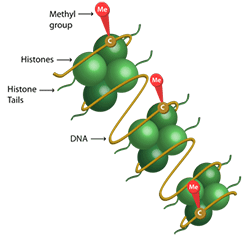DNA Methylation Analysis
DNA Methylation Analysis
Choose from a large number of kits developed for gene-specific or global DNA methylation analysis
DNA methylation was the first epigenetic mark to be discovered, involving the addition of a methyl group to the 5 position of cytosine by DNA methyltransferases, and can be inherited through cell division. DNA hydroxymethylation, caused by oxidation of 5-methylcytosine through the TET family of enzymes, was further discovered to be involved in switching genes on and off. DNA methylation plays an important role in normal human development and is associated with the regulation of gene expression, tumorigenesis, and other genetic and epigenetic diseases.

DNA Methylation Detection
Bisulfite and sodium bisulfite based techniques, often known as bisulfite conversion, are common approaches for preparing DNA for gene-specific DNA methylation analysis. Treatment of DNA with bisulfite converts cytosine to uracil while leaving 5-methylcytosine intact, allowing for single-nucleotide resolution information about the methylated areas of DNA. Popular methods for analyzing DNA methylation on a gene-specific basis, after bisulfite treatment, include bisulfite sequencing, methylation specific PCR, and methylation-based microarrays.
DNA Methylation Quantification
DNA methylation plays an important role in normal organismal development and in cellular differentiation in higher organisms. Gene expression, as well as the development of nearly all types of cancer, are also tied to DNA methylation. For example, global decrease in 5-methylcytosine content (DNA hypomethylation) is likely caused by methyl-deficiency due to a variety of environmental influences, and has been proposed as a molecular marker in multiple biological processes such as cancer. Global quantification of DNA methylation is crucial for understanding the roles that gene expression and silencing play in the development of cancer and other diseases.
Methylated DNA Immunoprecipitation
Methylated DNA immunoprecipitation (meDIP) is a large scale antibody-based technique that is used to enrich and capture methylated DNA fragments for use in gene-specific DNA methylation studies on a genome wide scale. Following meDIP approaches, DNA methylation can be analyzed using a variety of downstream applications including meDIP-PCR, meDIP-ChIP, and meDIP-sequencing.
DNA Methyltransferase & Demethylase Assays
DNA methyltransferases, or DNMTs, catalyze DNA methylation by adding methyl groups to the 5-carbon position of the cytosine ring, resulting in 5-methylcytosine. The various types of DNMTs are responsible for the maintenance and establishment of DNA methylation patterns. The ten-eleven translocation, or TET, family of 5-mC hydroxylase enzymes including TET1 are responsible for oxidizing 5-methylcytosine into 5-hydroxymethylcytosine. Measuring DNMT and TET amounts, activity, and inhibition levels will allow us to better understand the relationships between cytosine, 5-methylcytosine, and 5-hydroxymethylcytosine as part of the DNA methylation cycle.
Methylated DNA Amplification
Methylation specific PCR (MSP or MS-PCR) and bisulfite sequencing are some of the most commonly used methods for analyzing gene or sequence-specific DNA methylation data, usually after bisulfite treatment of DNA. After conversion, selective methylation amplification of a target region of methylated sequences with methylation primers is often necessary in methylation analysis protocols.